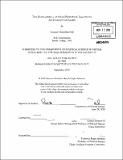The development of high definition television : an ecology of games
Author(s)
Neil, Suzanne Chambliss
DownloadFull printable version (12.74Mb)
Alternative title
The development of HDTV : an ecology of games
Other Contributors
Massachusetts Institute of Technology. Dept. of Political Science.
Advisor
Charles Stewart, III.
Terms of use
Metadata
Show full item recordAbstract
This study is an analysis of the forces that shaped the overall character of a new US television system, high definition or HDTV, between the early 1980s and 2010, with a primary focus on the period leading up the Federal Communications Commission decision on the new standard in 1996. The study tries to answer the question: how did we get the system we got? The analysis uses the model of an ecology of games that Norton Long developed and William H. Dutton refined. It shows that two camps, or "games," competed to define the new system. One game, consisting of the traditional television broadcast industry, saw HDTV as a standalone system, at first using the traditional analog technologies and then, midway through the process, switching to digital technologies. The second game, consisting of a lose group of academics and computer company representatives, saw HDTV as part of the emerging digital network. The result of the analysis shows that although the FCC was the legitimate forum for determining the standard, the technological system that finally emerged was the result of unplanned, uncoordinated political, social, and market forces.
Description
Thesis (Ph. D.)--Massachusetts Institute of Technology, Dept. of Political Science, 2010. Cataloged from PDF version of thesis. Includes bibliographical references (p. 235-246).
Date issued
2010Department
Massachusetts Institute of Technology. Department of Political SciencePublisher
Massachusetts Institute of Technology
Keywords
Political Science.
